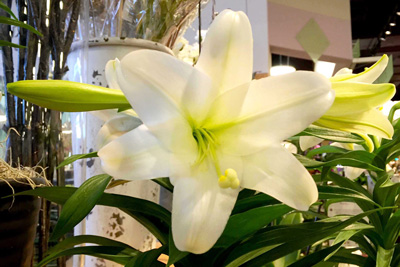Happy Easter (Lily), Gardener
For the Easter lily grower, whether for bulbs in the field or the finished potted product, life’s not a bed of roses. From my very first greenhouse management course in college, I’ve always known that these beautiful flowers are probably the most challenging crop that we grow.
Easter lilies are botanically Lilium longiflorum, and they’re native to the southern islands of Japan. In the late 1800s most of the bulbs were produced in Bermuda and shipped to the United States, but then the Japanese assumed the leadership position.

However, when the U.S. involvement with World War II began with the invasion of Pearl Harbor, those shipments were shut down immediately, and growers on the Pacific West Coast flew into business. By 1945 there were 1,200 growers along the coast, but that number has dwindled now to only 10 farms that now produce 95 percent of our nation’s bulbs, all from parts of two counties on the California/Oregon border.
It takes three to four years to produce a mature, flowering-size bulb. During that period each bulb is handled as many as 40 times, first as small bulblets along the stems of the mother plants, then on to yearlings and eventually as mature, salable bulbs.
The bulbs are harvested in fall, then stored very carefully until they are shipped to growers who plant them soon after they empty their greenhouses of poinsettias.
As the Easter lilies begin to grow and develop, it’s a game to raise temperatures gently to keep the plants growing or lower them somewhat to slow down the bud opening. The growers want the buds to be opening 5-7 days before Easter. The tricky thing is that any major changes in temperature are likely to cause buds to abort, and every bud lost brings a corresponding loss of sales price.

Useful facts about your lily…
Here are a couple of things you might want to know.
• Pinch out the anthers with tweezers before they open and expose the pollen. That will keep the flowers looking pristine and clean for the longest time. It will also keep pollen off your clothes as you work around the flowers.
• If you should get pollen on your sleeves or jacket, don’t try to brush it off. It has a greasy nature to it. Instead, lay it out in the sunshine for a few hours. It will disappear. It sounds crazy, but it works!
• Yes, you can plant your Easter lily into the garden once it quits blooming. Find a moist, semi-shady spot where you’ve prepared the soil well for other plants and then set it at the same depth at which it was growing in its pot. It will bloom later next year, but it should bloom.
